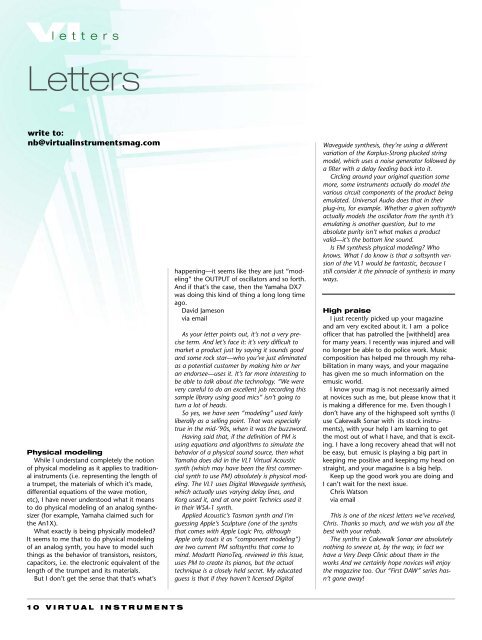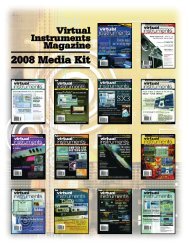Akai EWI 4000m Electric Wind Instrument Akai EWI 4000m Electric ...
Akai EWI 4000m Electric Wind Instrument Akai EWI 4000m Electric ...
Akai EWI 4000m Electric Wind Instrument Akai EWI 4000m Electric ...
Create successful ePaper yourself
Turn your PDF publications into a flip-book with our unique Google optimized e-Paper software.
VI letters<br />
Letters<br />
write to:<br />
nb@virtualinstrumentsmag.com<br />
Physical modeling<br />
While I understand completely the notion<br />
of physical modeling as it applies to traditional<br />
instruments (i.e. representing the length of<br />
a trumpet, the materials of which it’s made,<br />
differential equations of the wave motion,<br />
etc), I have never understood what it means<br />
to do physical modeling of an analog synthesizer<br />
(for example, Yamaha claimed such for<br />
the An1X).<br />
What exactly is being physically modeled?<br />
It seems to me that to do physical modeling<br />
of an analog synth, you have to model such<br />
things as the behavior of transistors, resistors,<br />
capacitors, i.e. the electronic equivalent of the<br />
length of the trumpet and its materials.<br />
But I don’t get the sense that that’s what’s<br />
10 VIRTUAL INSTRUMENTS<br />
happening—it seems like they are just “modeling”<br />
the OUTPUT of oscillators and so forth.<br />
And if that’s the case, then the Yamaha DX7<br />
was doing this kind of thing a long long time<br />
ago.<br />
David Jameson<br />
via email<br />
As your letter points out, it’s not a very precise<br />
term. And let’s face it: it’s very difficult to<br />
market a product just by saying it sounds good<br />
and some rock star—who you’ve just eliminated<br />
as a potential customer by making him or her<br />
an endorsee—uses it. It’s far more interesting to<br />
be able to talk about the technology. “We were<br />
very careful to do an excellent job recording this<br />
sample library using good mics” isn’t going to<br />
turn a lot of heads.<br />
So yes, we have seen “modeling” used fairly<br />
liberally as a selling point. That was especially<br />
true in the mid-’90s, when it was the buzzword.<br />
Having said that, if the definition of PM is<br />
using equations and algorithms to simulate the<br />
behavior of a physical sound source, then what<br />
Yamaha does did in the VL1 Virtual Acoustic<br />
synth (which may have been the first commercial<br />
synth to use PM) absolutely is physical modeling.<br />
The VL1 uses Digital Waveguide synthesis,<br />
which actually uses varying delay lines, and<br />
Korg used it, and at one point Technics used it<br />
in their WSA-1 synth.<br />
Applied Acoustic’s Tasman synth and I’m<br />
guessing Apple’s Sculpture (one of the synths<br />
that comes with Apple Logic Pro, although<br />
Apple only touts it as “component modeling”)<br />
are two current PM softsynths that come to<br />
mind. Modartt PianoTeq, reviewed in this issue,<br />
uses PM to create its pianos, but the actual<br />
technique is a closely held secret. My educated<br />
guess is that if they haven’t licensed Digital<br />
Waveguide synthesis, they’re using a different<br />
variation of the Karplus-Strong plucked string<br />
model, which uses a noise generator followed by<br />
a filter with a delay feeding back into it.<br />
Circling around your original question some<br />
more, some instruments actually do model the<br />
various circuit components of the product being<br />
emulated. Universal Audio does that in their<br />
plug-ins, for example. Whether a given softsynth<br />
actually models the oscillator from the synth it’s<br />
emulating is another question, but to me<br />
absolute purity isn’t what makes a product<br />
valid—it’s the bottom line sound.<br />
Is FM synthesis physical modeling? Who<br />
knows. What I do know is that a softsynth version<br />
of the VL1 would be fantastic, because I<br />
still consider it the pinnacle of synthesis in many<br />
ways.<br />
High praise<br />
I just recently picked up your magazine<br />
and am very excited about it. I am a police<br />
officer that has patrolled the [withheld] area<br />
for many years. I recently was injured and will<br />
no longer be able to do police work. Music<br />
composition has helped me through my rehabilitation<br />
in many ways, and your magazine<br />
has given me so much information on the<br />
emusic world.<br />
I know your mag is not necessarily aimed<br />
at novices such as me, but please know that it<br />
is making a difference for me. Even though I<br />
don’t have any of the highspeed soft synths (I<br />
use Cakewalk Sonar with its stock instruments),<br />
with your help I am learning to get<br />
the most out of what I have, and that is exciting.<br />
I have a long recovery ahead that will not<br />
be easy, but emusic is playing a big part in<br />
keeping me positive and keeping my head on<br />
straight, and your magazine is a big help.<br />
Keep up the good work you are doing and<br />
I can’t wait for the next issue.<br />
Chris Watson<br />
via email<br />
This is one of the nicest letters we’ve received,<br />
Chris. Thanks so much, and we wish you all the<br />
best with your rehab.<br />
The synths in Cakewalk Sonar are absolutely<br />
nothing to sneeze at, by the way, in fact we<br />
have a Very Deep Clinic about them in the<br />
works And we certainly hope novices will enjoy<br />
the magazine too. Our “First DAW” series hasn’t<br />
gone away!



